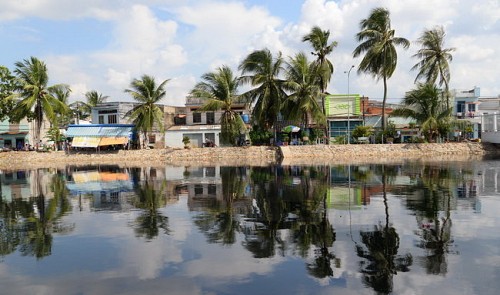It is apparently not easy for an industry association to sell its plan to grow coconut trees along streets and canals in Ho Chi Minh City, as local residents and architects have myriad reasons, not just the worry about falling fruits, to reject the idea.
Thousands of readers have expressed their concern to Tuoi Tre(Youth) newspaper after learning that the Vietnam Coconut Association proposed growing 100,000 coconut trees along newly-opened or canal-side streets in Ho Chi Minh City last weekend.
“The first thing that came to my mind then was that my kids may be hurt by falling coconuts,” Minh Trang, a District 8 resident, told Tuoi Tre.
The Vietnam Coconut Association said coconut trees would create a “beautiful and environmentally-friendly landscape typical of Vietnam’s southern region” to the metropolis, and the rain- and storm-resistant plants would also help protect the city against foul weather.
But Doan Trang, another Tuoi Tre reader, does not think “the beauty coconut trees may bring would be suitable for a modern city like Saigon.”
The Vietnam Coconut Association said coconut trees can be easily planted on almost every type of soil, and do not require much effort to care for.
The city’s urban greening agency would thus be able to save costs in having employees take care of the trees, and could even gain economic benefits by selling the coconut fruits, it said in a proposal submitted to the municipal administration.
The association thus suggested that coconut trees be planted along the two sides of the Tau Hu Canal in District 8 on a trial basis to test the effectiveness of its plan.
But local architects do not find the plan feasible.
Tran Huy Anh, from the Vietnam Architect Association, said while it would be reasonable to grow coconuts along canal-side streets, most of the roads along Ho Chi Minh City canals are already paved with a concrete surface.
“So it would not be easy to plant the trees there,” he said.
The architect added that the coconut trees may also attract insects able to cause disease outbreaks.
Coconut trees are usually planted along sand beaches and Anh has never seen the plants grown inside a city, he said.
“Growing a type of hybrid coconut trees, which will produce no fruits, may work but the landscapes they create would then no longer be typical of southern Vietnam,” he said.
Former Deputy Minister of Construction Tran Ngoc Chinh, who is now chairman of the Vietnam Urban Planning and Development Association, said the proposition of the coconut association is “not really good.”
Chinh echoed Anh’s comment, saying he has never seen any proposals to grow coconut trees only to “reflect the distinctive characteristics of southern Vietnam.”
“Growing rows of coconut trees along the streets in the city would just threaten the safety of passers-by,” he said.
Coconut is in fact listed among 28 plants that should not be planted along Ho Chi Minh City streets, according to Directive No.52 released by the city’s administration in November 2013.
These include toxic plants that are harmful to human health, or those that can affect the safety of passers-by or the environment.
Coconut is included in the list because it has big fruits that may fall down and cause danger, according to the document obtained by Tuoi Tre.






















































